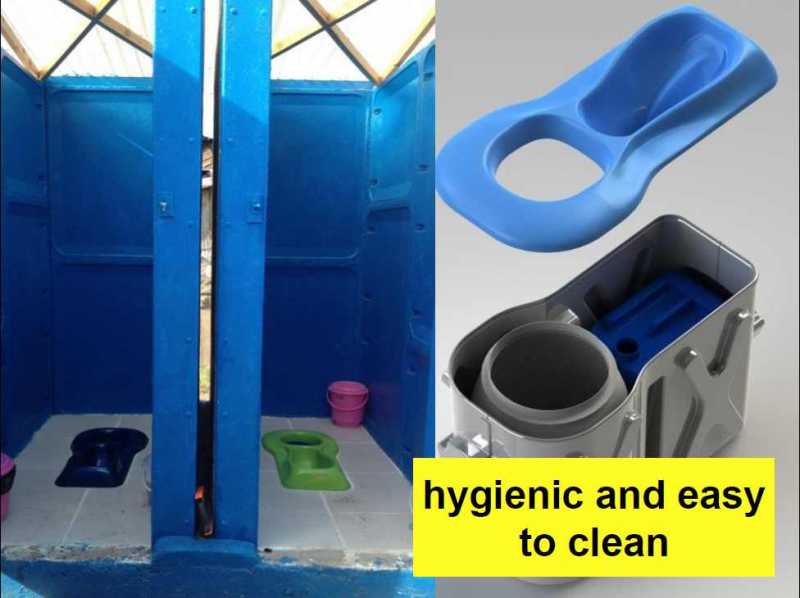Welcome back! Today’s topic is one of Nairobi’s circular economy. The circular economy is a model of production and consumption in which existing materials are shared, reused, leased, repaired, reconditioned and recycled. In this way, the life cycle of the products is extended. In practice, this means that waste is reduced to a minimum. Materials can be used productively, again and again, to continue generating added value (Myers, 2005; Stahel, 2016).
One example of circular economy in Nairobi’s informal settlements is the reuse of human excrements. Sanergy is a social profit providing so-called “Fresh Life” centres that constitute toilets, freshwater and showers, as illustrated by the image below. The centres, made of prefabricated and easy-to-clean building elements, are rented out for the equivalent of 450 euros a year to young entrepreneurs. They collect their costs through entrance fees for the centres – around 5 cents per visit to the toilets.

Human excrements are collected hygienically in safe containers and then transported for treatment and recycling. Since 2010, this container-based solution (CBS) has been emerging as a viable low-cost option for sanitation service delivery, particularly in low-income urban settlements where the need for sanitation services is high and infrastructure would be costly to install. The portable nature of CBS makes it appealing in low-income urban contexts as it requires little space and limited to no in-house construction.
Sanergy also offers an end-to-end service which entails the safe removal and transportation of all waste generated by the residents to a central processing plant, where it is treated and converted into agricultural inputs – organic fertiliser and insect-based animal feed. This closed-loop solution leaves zero waste behind, thus contributing to the emerging circular sanitation economy.
Circular Economy principles are increasingly becoming a business imperative, as circular business models allow companies to reduce costs and generate new revenue streams. Following this principle, Sanergy is formed of two independent entities, profit and non-profit. Sanergy’s profit arm collects waste and processes it into fertiliser and insect-based animal feed which is then sold to farmers. The non-profit arm has built the sanitation network by unlocking digital solutions.
Have a look at the video below, illustrating the different venue streams of the reuse of human excrements!
Sanergy has now leased more than 250 such centres and sells 25 tonnes of excrement a month – mainly to flower farmers who plant roses, tulips and orchids for European buyers. In this way, shit doesn’t necessarily turn into gold – but at least it turns into fragrant birthday presents.
425 words
VISUAL REFERENCES
Featured image: Banks, M. (2019). Circular Economy. Retrieved from https://www.eupoliticalreport.eu/tag/circular-economy/
Sanergy (2017). Fresh Life Toilets. Retrieved from https://na.eventscloud.com/file_uploads/6470738ab794490f6ad51dab7717c31c_Sanergy-TJ.pdf

Hi, thank you for this very original post! Excrement has also been analysed by our colleague reporting on Dakar, Senegal, where it is recycled in a much more complex process involving a technology developed by Bill Gates’ philanthropic association. Thus, comparing your two analysis is very interesting: it seems Sanergy’s solution has found many different possibilities to reuse excrements in a meaningful way, with much simpler technology. Therefore, although I am sceptic of Dakar’s imported high-tech solution requiring heavy foreign investment, Nairobi’s technology seems ready to be implemented elsewhere in Africa or Southeast Asia, where informal settlers face similar issues. Do you know if Sanergy has any plans to develop this activity in other countries?
LikeLike
Hi Franklin, thanks for your comment. I have also read the blog on Dakar and it’s really interesting to compare the different approaches to sanitation upgrading. I believe that the toilets provided by Sanigal have great potential. Hygiene is a huge problem in the informal settlements of Nairobi and since these toilets are constantly being cleaned, they meet a need. However, it must be remembered that these toilets cost money and many people cannot afford to spend even a few cents on toilets. So the toilets are not made for all in Nairobi’s informal settlements.
Concerning your question, Sanergy has started to provide these toilets in three informal settlements in Nairobi. I am not aware of any future plans Sanergy has and I didn’t find any information on their website. But I could imagine that Sanergy is trying to expand in other slums in Nairobi first. That would make sense because they have built up a network of locals in Nairobi already, including locals living in Nairobi’s informal settlements themselves. This network is essential for such a company, because people in Nairobi’s informal settlements often only trust other locals. This is what people reported during my research stay in Nairobi last year.
LikeLike